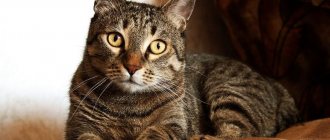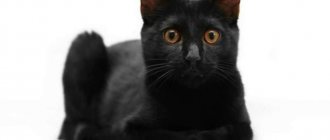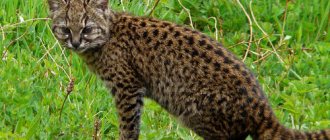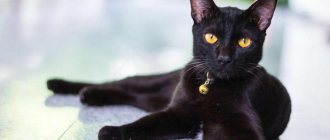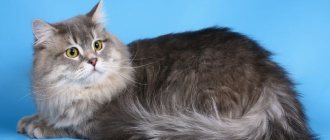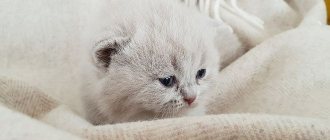Black cats are not a separate species, but a color that occurs in different breeds. In the wild, black coat color is an advantage, because at night the hunter is practically invisible. Until now, the attitude towards cats with black fur coats is not clear. Someone, remembering the signs, will bypass them, while others will be attracted by the aura of mystery that envelops black cats. What breeds of black cats are there?
Bombay cat
The Bombay is a robust, medium-sized, heavily built cat with a softly contoured body, a broad head, a short muzzle and large, round eyes of rich color, ranging from gold to bright orange. The Bombay's coat is very short, smooth and, one might say, "shiny".
Breed standards allow only one color - jet black. Despite their exceptionally spectacular, in a sense, “fatal” appearance, these cats are very friendly, sociable, and get along well with all family members and other pets. Breeders, not devoid of a sense of beauty, call the Bombay “a bundle of brilliance and love.”
The history of Bombay is not original. In the middle of the last century, the American N. Horner, the “godmother” of the breed, decided to create a unique, “powerful” cat - a mini-panther. For breeding work, she attracted American shorthairs of black color and Burmese sable color (the so-called dark brown color of the Burmese fur coat). Not everything went smoothly: Horner spent more than 20 years developing the breed.
Bombays were first recognized by the CFA feline system in 1976, and subsequently by other American systems. The most influential European systems - GCCF and FIFe do not recognize Bombay, but they are recognized by the WCF. However, these magnificent, “magical” cats are not very popular among us.
catalogue of articles
By Orca Starbuck and David Thomas (Adapted from Cat Fanciers)If you are interested in the genetic basis for obtaining different colors, as well as what colors are theoretically possible, this article is for you.
- Pigmentation
- White color
- Ticking and Tabby
- Shaded
- With white spots
- FAQ
- Explanations of the notations in the article
Cat colors come in a variety of patterns and colors. The names for these colors are often based on genetic theory. Many people are confused when faced with the names of colors that exist among cat lovers. This article will help to understand these terms and the reasons for their occurrence, but does not attempt to describe the mechanisms of inheritance and does not provide formulas for calculating the possible result of crossing different colors.
Pigmentation
The color of fur, skin and eyes depends on the presence of melanin in them. Melanin is found in the hair body in the form of microscopic granules that vary in shape, size and quantity, which causes differences in color.
There are two chemical varieties of melanin: eumelanin and phaeomelanin. Eumelanin granules
spherical and absorb almost all light, giving black pigmentation.
Phaeomelanin
granules are oblong (ellipsoidal in shape) and reflect light in the red-yellow-orange range.
Some genes can change the density of melanin granules in such a way that different colors are produced.
The greatest differences are observed in dark (eumelanin-based) colors. Table of common names of basic colors by genotype:
| Saturation | |||
| Max | Min | ||
| Dark (eumelanin-based) | Black (B-) | Black | Blue |
| Brown (bb) | Chocolate | Lilac | |
| Light brown (b1b1) | Cinnamon | Deer (fawn) | |
| Red (phaeomelanin-based) | Orange (O(O)) | Red | Cream |
With a decrease in the number of eumelanin granules in the hair body black
the color changes through
chocolate
(or chestnut) to
cinnamon
.
Chocolate is recessive to black, and cinnamon is recessive to chocolate. Such mutations will be caused by allele (B).
Mutations of dark group genes lead to the appearance of blue
,
lilac
and
fawn
.
This is due to the grouping of pigment particles in the hair body. Cyan is a diluted black and represents different shades of grey. Lilac is a diluted chocolate color and is sometimes compared to the color of frost or lavender. Fawn (fawn) is a diluted cinnamon color - the color of café au lait or caramel. Such mutations depend on the location of the allele (D)
. Dilution is recessive relative to saturated shades.
Red-based (phaeomelanistic) colors have significantly less variation. Red
the color is usually described as orange or marmalade, and in Russian - red.
Some cats have such pale pigmentation that they can be called yellow. Cream
is a diluted red, the color of cream.
For the red gene, use the symbol (O)
. Black color is recessive to red.
Red gene (O)
linked to the X chromosome, so it is gender dependent.
Cats have one X chromosome, so if a cat carries the red gene, it will be red. Cats have two X chromosomes, so a cat will be red if both X chromosomes carry the red gene. However, in many cats, the red gene is carried on only one chromosome, resulting in black pigmentation in the form of patches. This combination of red and black is called Tortoiseshell
.
Typical Tortoiseshell
color is randomly located spots of black and red.
Some have more red, some have more black. Depending on the saturation, the spots can be either black-orange or blue-cream (these are usually not called tortoiseshell, but simply called blue
).
Variations of black result in the Chocolate Tortie
and
Cinnamon
Tortie, with diluted versions called
-Cream Tortie and
the Tortie
.
The described mutations have existed in Europe and the Western Hemisphere for hundreds of years. Another set of mutations was introduced from Asia, and is represented by Siamese and Burmese cats. Burmese carry the genes for the Sepia
(Sepia)
(cb)
Pointed
(cs)
color spot genes .
Such mutations are caused by the allele (C)
, their combination
(cb/cs)
, as in the Tonkin cat, represents the
mink
(mink).
| Plain (C-) | Sepia (cbcb) | Mink (cbcs) | Point (cscs) |
| Black (BD-) | Sable Wax Sepia | Wax (Seal Mink) Natural (Natural Mink) | Seal-point |
| Blue (B-dd) | Blue Sepia | Blue Mink | Blue-point |
| Chocolate (bbD-) | Chocolate Sepia Champagne | Chocolate Mink Champagne Mink | Chocolate point |
| Lilac (bbdd) | Purple Sepia Platinum | Lilac Mink Platinum Mink | Lilac point Platinum point (Lilac-point) |
| Cinnamon (b1b1D-) | Cinnamon Sepia | Cinnamon Mink Honey Mink | Cinnamon-point |
| Fawn (b1b1dd) | Fawn Sepia | Fawn Mink | Fawn-point |
| Red (DO(O)) | Red Sepia (Fawn Sepia) | Red Mink | Red point, red point (Flame-point) |
| Cream (ddO(O)) | Cream Sepia (Fawn Sepia) | Cream Mink | Cream-point |
Not shown in the table are two more colors of the albino mutation, which usually have a solid white coat, regardless of pigmentation genes. These are white with blue eyes (ca/ca), and white with pink eyes (c/c).
2. White cats
White color is the absence of any pigmentation. Solid white wool can be obtained in three completely different cases:
White albino.
This is a recessive variant, described in the previous section
Solid white spots
White spot factor (S)
is not completely dominant, is subject to polygenetic modifications and usually results in the cat not being entirely white. However, the spots may be so dense that the animal appears completely white. White spots are described in the next section.
Dominant white
This mutation suppresses all other pigmentation genes, and results in white coat color and blue eyes. As the name suggests, this is the effect of the dominant white gene (W)
.
In the dominant white, genes for other colors and patterns, although present, are completely hidden. The only way to determine the underlying genotype is by crossing with colored cats of a well-known genotype.
Crossing two dominant whites will usually result in all white kittens, but if both parents are heterozygous (W/w)
, then some kittens may show primary colors. If the genotype of the white parents is not known from the pedigree or test crosses, the mating result is unpredictable.
Dominant white is found in a variety of breeds. Sometimes white Oriental Orientals are considered by some associations as a separate breed. The dominant white color has a much deeper blue eye color than albinos, and this is considered an advantage. The best blue eye color is observed in completely white Oriental Oriental cats that carry a suppressed chocolate gene.
Deafness in cats is linked to spot (S)
, and with a dominant white
(W)
, but not with the albino gene (
c/c
or
ca/ca
).
Ticking and Tubby
The previous paragraphs described solid colors. However, these colors are not the most common. Many cats are ticked, and most are ticked in a different color than the main one, a pattern called tabby.
Ticking is the result of the manifestation of the agouti gene.
- designated
(A)
, leading to the appearance of stripes of light and dark pigmentation on each hair. The agouti gene allows full pigmentation for hair that has begun to grow, then slows down pigment synthesis for a while, and allows it again. When the hair reaches its full length and stops growing, pigment synthesis stops. As a result, the hair is densely colored at the tip, then there is a stripe of yellow or orange color, then again a densely pigmented area, descending to the yellow or orange root of the hair.
Agouti stripes are found in both eumelanistic and red base colors. In both cases, the band corresponds to a period of slowing melanin production. Agouti stripes in black-based colors are also caused by eumelanin (not phaeomelanin), but the pigment granules are sparse and arranged in islands, giving a yellow or orange tint. Thus, agouti is not a mixture of areas with eumelanin and phaeomelanin pigmentation.
In eumelanin-pigmented hairs, agouti stripes are usually yellowish
shades.
However, their color can be orange
- this color is caused by the
red
color factor.
This polygenetic factor has not yet been isolated or identified, but breeders know how to select animals that produce warm tabby colors. In particular, the Brown Tabby
is genetically black, but by selecting individuals with a strong red factor it was possible to obtain a rich brown color in the ticked hairs.
The mutation responsible for uniform color is called non-agouti
(non-agouti)
(a/a)
and is recessive. The effect of non-agouti suppresses ticking so that the pigment is evenly distributed along the entire length of the hair, except at the root, where ticking is usually preserved to some extent.
For the tabby
responds to the gene
(T)
, which causes the appearance of stripes and spots of the primary color on the ticked coat. Commonly known types of tabbies are given the following descriptive names:
Tiger Tabby (Mackerel Tabby).
Ticked hair in stripes is located on the main color (like a tiger). This is the most common tabby pattern.
Classic Tabby.
The ticked hair is arranged in patches, often in the shape of "bull's eyes" on the sides, or "butterflies" on the back. This pattern is also called spotted tabby.
(Blotched Tabby).
Ticked Tabby.
Ticked hair is evenly distributed throughout the body, the coat looks as if freckled. This pattern is also called Agouti.
(Agouti Tabby),
Abyssinian
(Abyssinian Tabby) or wild.
Patched Tabby.
The ticked hair alternates with spots or rosettes of the primary color (as on a leopard or jaguar).
Agouti and tabby genes in combination with the basic colors produce the following patterns:
| Agouti(A-) | Non-agouti(aa) | |||||
| Ticket Ticked | Brindle Mackerel | Classic Classic | Ticket Ticked | Brindle Mackerel | Classic Classic | |
| (Tb) | (T-) | (TbTb) | (Tb) | (T-) | (TbTb) | |
| Black (BD-) | Brown ticked tabby | Brown brindle tabby | Brown classic tabby | Black Solid | ||
| Blue (B-dd) | Blue ticked tabby | Blue brindle tabby | Blue classic tabby | Blue Solid | ||
| Chocolate (dd B-) | Chocolate ticked tabby | Chocolate brindle tabby | Chocolate classic tabby | Solid Chocolate Chocolate Solid | ||
| Lilac (bb dd) | Lilac ticked tabby | Lilac brindle tabby | Lilac classic tabby | Solid Chocolate Chocolate Solid | ||
| Cinnamon (b1b1D-) | Cinnamon ticked tabby | Cinnamon brindle tabby | Cinnamon classic tabby | Solid Cinnamon Cinnamon Solid | ||
| Fawn (b1b1dd) | Ticked tabby fawn | Tiger tabby fawn | Classic tabby fawn | Fown Solid | ||
| Red (DO(O)) | Red ticked tabby | Red brindle tabby | Red classic tabby | Same as Agouti (A-) Non-agouti does not show up on orange pigment | ||
| Cream (ddO(O)) | Cream ticked tabby | Cream brindle tabby | Cream classic tabby | |||
Classic tabby (tb)
recessive relative to brindle
(T)
, brindle recessive relative to Abyssinian
(Ta)
.
Agouti and tabby genes are also combined with all albino colors - sepia, mink and colorpoints. Americans recognize the Burmese and Tonka breeds only with the black-based non-agouti color (eumelanistic non-agouti) color, without recognizing tabby manifestations. The Singaporean (Singapura) recognizes only “ sable agouti”
"(Sable Agouti Tabby) color -
sepia
ticked tabby.
Some associations allow tabby Siamese cats - their color is called Tabby Point, or Lynx Point
- with a lynx spot.
Note that there are no solid red or cream colors here. Although breeders produce uniformly colored red and cream cats by selecting for carriers of the red gene with a tendency to reduce pattern contrast, the "M" on the forehead is still present in even the most uniform red-base (Phaeomelanistic) colors.
Ticked tabby in relation to Abyssinians and Somalis (Abyssinians, Somalis) is given special names:
- Ruddy Abyssinian = Brown Ticked Tabby
- Blue Abyssinian = Blue Ticked Tabby
- Sorrel Abyssinian = Cinnamon Ticked Tabby
- Fawn Abyssinian = Fawn Ticked Tabby
Sorrel
Abyssinian is sometimes called
red
, but this is incorrect.
All these colors are black-based. The Red and
Cream colors of the Somali and Abyssinian are not recognized by US associations.
Note that spotted tabby is not identified as a separate genotype. It is not entirely clear whether the spotted tabby is a mutation of the tabby gene, or whether it is simply the effect of polygenetic modifications of the mackerel tabby. Some breeders point to the existence of spotted tabby in various species of wild cats, as confirmation that the spotted tabby is an independent mutation. In practice, however, the spotted tabby produces offspring with patterns ranging from spotted to brindle, and breeders must continually select sires with clear markings, otherwise the pattern of the offspring will shift to brindle.
Tortoiseshell cats can also have a tabby pattern. In tortoiseshell tabby
(torbie), the tabby pattern appears on both red and black areas. Solid and ticked stripes on red areas continue without interruption to black areas.
Shaded
In a regular tabby, the ticked hairs have light stripes, but they are not devoid of color. Typically, the light stripes are yellowish in color, but can sometimes appear orange.
Less commonly, agouti stripes add a tint to the main color. Shaded
(Shading) expands the agouti stripes so that the light areas can reach the root of the hair.
This effect results in the hair having a colored tip, the color of which is determined by the base color gene, and the hair itself is much lighter. If the light area of the hair is white, it is Silver
, if it is yellow or cream, it is
Golden
.
There have been several explanations for the genetics of shaded colors. Previously it was believed that the chinchilla gene (Ch)
(Chinchilla) is a modification of the albino gene.
If this were the case, then colors such as shaded sepia, mink and colorpoint would not be possible. Breeder experiments refute this theory. It was later thought that a separate gene, called the inhibitor
(I), caused the shading. But this theory could not explain all the varieties of shaded colors and the success of breeders in obtaining them. Therefore, it is now believed that at least two genes cause shading, however, this theory has not yet been proven experimentally.
All of these theories try to explain hereditary factors that suppress pigment synthesis after hair reaches a certain length. The combination of shading with agouti and tabby results in colors such as chinchilla
Chinchilla,
Silver
,
Tabby
and
Smoke
.
At the chinchilla
(Chinchilla) each hair is well colored at the end and pale to the root, so all the hair appears lightly colored and there is no tabby pattern effect. The tipping is so weak that the color even seems white at first glance, but upon closer inspection it seems to sparkle.
In Shaded Silver
(Shaded Silver), all hair is colored where the agouti stripe usually begins. Like the Chinchilla, the ticked and solid areas are pale colored where agouti stripes would normally be, so the pattern is not noticeable. However, in Shaded Silver the colored tips are long enough so that the underlying color is clearly visible, especially on the head and back.
At Silver Tabby
(Silver Tabby) Ticked hair is brightly colored at the ends and pale to the root, but solid hair has normal color saturation. The tabby pattern is enhanced by the contrast between the almost white ticked coat and the areas of base color.
Smoky
(Smoke) pattern is the result of shading a solid non-agouti color. All hairs are well colored to the point where an agouti stripe would appear and then fade into an almost white undercoat. This color looks like the main color, but if you blow on the coat, a contrasting and white undercoat is noticeable. It is also clearly visible when the animal moves.
The same shaded patterns can be found on the golden undercoat. They are called Golden Chinchilla
Golden Chinchilla,
Shaded
Golden,
Tabby
and
Golden
Smoke. Unlike white (silver) shaded animals, these animals have an undercoat of warm cream or apricot color.
The eumelanistic shaded colors are the most impressive as they have more contrast, but the red and cream colors are also very beautiful. Red-based shaded colors are often called "Cameo"
, their correspondence to the usual names is given below:
- Shell Cameo = Red Chinchilla
- Shaded Cameo = Red Shaded Silver
- Cameo Tabby = Red Shaded Silver
- Smoke Cameo = Red Smoke
Since shading is combined with both black-base and red-base colors, it can appear in all tortoiseshell colors.
Theoretically, golden undercoat can also be obtained in a red-base color, but so far breeders have not found such a combination worthy of attention. Lack of contrast in Red Gold Shaded
makes the effect almost indistinguishable, but in the black spots
of the Golden Tortoiseshell Shaded
or
Golden Tortoiseshell Chinchilla
it can be quite noticeable.
With white spots
A very common mutation that results in white spots. The spotted color is sometimes called "piebald". There are a lot of varieties of spots - from white slippers, white feet, to a white nose or chin. From small white areas to almost complete absence of areas with the main color.
White spots can be considered a mask on the main color. Typically, owners of cats that have dark stripes only on the head and tail consider their pets to be white
. This is not correct - in fact, these are cats with a tabby pattern that is hidden under white spots.
White spots are found in any color and in any of the patterns described above. It is generally accepted to name such colors by indicating the main color and adding “ with white ”. For example, Red Tiger Tabby
(Red Mackerel Tabby) with white spots is called
and
White, and
Lilac
becomes
Lilac and White
.
Tortoiseshell with white
(Tortoiseshell and White) has a special name -
Calico
(Calico, Chintz).
Hence, Blue Cream and White
is sometimes called
calico .
White spot factor (S)
- dominant mutation.
Homozygous (S/S)
usually have more white patches than heterozygous
(S/s)
, but other genes can change the extent of the white patches. Sometimes white spots can increase with age (!).
The white spot factor can result in blue-eyed cats and cats with mixed eyes if the spot covers one eye. This gene is associated with deafness, especially if the white patches reach the ears. If the white patch covers the eyes and ears, then it is possible that the result will be a deaf cat with blue eyes. Deafness can affect one or both ears. This is caused by degeneration of the concha of the inner ear, which begins in the first days of life. Such deafness is incurable.
It has been observed that a white spot may be present on a white
color! Of course, a spot on white is visually indistinguishable.
FAQ
Is it true that there are no tortoiseshell cats?
Tortoiseshell, blue-cream, patched tabby, calico, etc. colors are gender dependent. Therefore, they appear only in cats. It is extremely rare that they can appear in cats, but this is a genetic disorder. These cats have XXY instead of the normal XY chromosome combination and are usually infertile.
Why do all red cats have a tabby pattern?
This is the result of the manifestation of the agouti gene. The agouti gene regulates the presence of stripes of different colors on the hairs of the coat. The recessive non-agouti gene suppresses tabby and leads to uniform hair color along the entire length. This non-agouti gene does not affect the red pigment, so the tabby is always visible. Even a cat that is solid in non-red areas has tabbies in the red areas.
Is it true that there are only 3 main cat coat colors?
Yes its true. This is black, red and white. These colors appear to varying degrees under the influence of attenuating genes. Black fades into blue (various shades of gray, including silver) and chocolate (lilac and light brown). Light brown lightens to yellow-brown (fawn) and red to cream.
My cat is not a Siamese, then why does she have a Siamese color?
The Siamese spot (mask) gene comes from cats from Asia. These cats have been crossed with other breeds and the gene is now widespread and present in many non-Siamese cats. This gene is temperature sensitive and causes darkening of the extremities (ears, tail, muzzle) that are more sensitive to cold. Kittens are born completely white. If they live in cool conditions, their coat will darken as they age, while kittens raised in warm conditions will have a light coat, and sometimes only a small spot on the nose will darken. What's very interesting is that if you bandage a cat's leg, the new fur that grows under the bandage, where it's warmer, will be lighter than in the exposed areas. This is immediately unnoticeable, because old dark hair does not change color. As the cat sheds, the white patch will gradually appear. Spot areas will also lighten if your cat has been sick for a long time with a fever.
Why did two short-haired cats give birth to a long-haired kitten?
Recessive genes, in addition to the genes for calico color and true white coat color in cats with blue eyes, are also genes for long hair. They are spun, on average, every third generation. Therefore, if a long-haired cat is born with two short-haired cats, then that kitten's grandparents were long-haired.
What color can cats' eyes be?
Eye color is always genetically linked to color.
Colorpoint cats have blue eyes.
White cats and cats with white dominance may have:
- blue eyes - green, yellow, light brown - multi-colored (one blue, the other yellow or green).
Other cats may have yellow, green, but not blue eyes. Most cats have greenish-yellow to gold eyes. Colors such as “deep green” or “rich copper” are found in purebred cats that were specially bred to obtain this eye shade, but can sometimes appear in ordinary cats.
Are all white cats deaf?
The dominant white gene carries hereditary characteristics that weaken the structure of the inner ear in true white cats with blue eyes. In cats with different colored eyes, the ear on the side of the blue eye cannot hear. True white cats do not have a yellowish tint, they have pink skin and pink paw pads, and blue eyes without rims or spots of another color. White color can also be caused by a recessive albino gene, which does not cause deafness.
7. Explanations of notations in the article
The article uses designations generally accepted in genetics, which, however, are not necessary to understand the essence of the matter. Typically, genes for different characteristics are designated by letters, usually the first letter of the gene name. Mutations of a gene are called allomorphs, or more commonly, alleles. Dominant alleles are indicated in capital letters, recessive alleles are indicated in lowercase letters.
Typically in genetics, multiple alleles are distinguished by superscript letters. For example, Black is (B), Brown is (b), and Light Brown is designated b l. The article did not use superscript characters, so it turns out (bl).
Every cat has a pair of genes for each trait, one from each parent. A purebred black cat is designated as (B/B), and a chocolate (chocolate (brown)) cat is designated as (b/b). These are called homozygotes
, since they received the same set of genes from both parents. A black cat with a recessive gene for chocolate color is designated as (B/b) - its parents have different genes.
Cats with recessive traits (like (B/b)) are called heterozygotes
. They are indistinguishable from homozygous individuals; differences appear only in the offspring. If the presence of a dominant gene determines a visible trait, the paper used a form like (B/-), where the minus indicates that the second gene is unknown or not important for the visible trait.
Authors: Orca Starbuck and David Thomas (Based on materials from Cat Fanciers)
Source: https://www.thaicat.ru/publ/21-1-0-628
British Shorthair
A cat with a “rich” appearance - this is how the British can be described in a nutshell. Heavy bones, excellent proportions, a cheeky round head with small ears, huge eyes of a necessarily bright shade, a dense fur coat - so dense that the hairs are perpendicular to the skin... The Briton is magnificent in any color! True, there are not so many black British: under the influence of fashion and notorious advertising, fans of the breed prefer the “classics” - blue or silver animals.
This breed is the glory and pride of British breeders; for many decades it has been in the TOP 10 most popular in the world.
Persian
Persians are the embodiment of luxury. They have heavy bones and a “sweet” expression on their faces (by the way, this is a completely official term). The Persian fur coat evokes surprise and admiration, because representatives of other breeds do not have such long and thick fur. Despite the difficulties in caring for a Persian pet that needs to be thoroughly combed every day, this breed has long been at the top of the list of the most popular. Perhaps the meek disposition gained the Persians a lot of fans.
The breed has been actively developing for many decades. So active that now the appearance of Persians is very different from the usual appearance of a mongrel cat. Selection has had a bad effect on their health: they are the leaders in the number of breed-specific diseases.
Popular breeds
There are a huge number of different breeds of cats with unusual two-tone colors. However, only eight of them are popular among pet lovers.
Cornish Rex
Black Spitz: Pomeranian black and tan or black and white dog
These pets with an unusual name differ from other breeds by their short hair, elongated legs and long body. They also have a unique coloring called tuxedo. The chest and legs are painted white. The rest of the body is covered with dark fur.
Additional Information! Cornish Rexes have bright and unusual eyes. They can be colored olive, yellow and green.
Cornish Rex with unusual black and white coloring
Bobtail
Representatives of this cat breed have all three types of coat color. A distinctive feature of these cats is the light area located at the bottom of the muzzle. Externally, this light spot resembles an inverted letter “V”. Other distinctive features of bobtails include small paws, a short tail and long whiskers.
Maine Coon
This breed is very popular among those who like to have domestic cats. Most often, Maine Coons are painted in dark colors. However, sometimes there are animals with two-color colors. Most of this fluffy cat's body is covered with dark fur. Slight patches of lightened hair can be seen on the paws and chest.
Wang
They decided to name these cats after one of the color types, since their fur is almost all light. Dark spots are found on the head and tail. Less commonly, black fur grows on the paws.
Siberian
Siberian cats are difficult to confuse with other breeds, since an unusual pattern consisting of several spots can be seen on their body. They have very clear outlines and an unusual shape.
Two-color cat of the Siberian breed
Additional Information! The eyes of Siberian seals have a brightly colored yellowish iris with a greenish tint.
Fancy
The coloring of Neva masquerade cats differs from the colors of other breeds. Their spots do not have clear boundaries and therefore the shades have a smooth transition. The colors of representatives of the masquerade breed are asymmetrical. However, sometimes you can find animals with symmetrical colors.
Munchkin
This is a black cat with a white chest, which differs from other felines in its elongated body and small paws. Outwardly, these cats look very cute and unusual. They are very calm and ideal for keeping at home.
Ragamuffin
These are large black and white cats with a large elongated body. They have long hair and a large tail. The body is almost completely painted in a light color, with occasional dark spots.
Two-tone ragamuffin with dark gray coloring
Scottish lop-eared
How unusual a cat's head without ears looks! More precisely, with ears, but small and tightly pressed to the head. The charming muzzle with round eyes gives the Scots a resemblance to owlets. Representatives of this breed are of medium size, have a fairly dense build, and thick fur - like their ancestors, the British and American Shorthairs. Well, since the feature of the breed and the main concern of the breeders are ears that meet the standards, the color is not important (any color is allowed).
The unique Scottish ears are a manifestation of a random mutation discovered in an ordinary cat on a farm in Scotland in the 60s of the last century. British breeders immediately became interested in the mutation. It soon became clear that the descendants of fold-eared cats have serious health problems. In Great Britain, breeding work was prohibited. But the “owls” attracted not only the British. US breeders have found that kittens will be born completely healthy if one of the parents has normal ears. Therefore, among Scots, about half have normal ears.
Black color standards
According to all international standards, the black color code is n (sil, ebony, wild, sable). The outer coat, as well as the undercoat of the animal, must be evenly and evenly colored, each hair painted completely from the base to the very tip. No white or colored inclusions are allowed (spots, stripes, stains, etc.).
The coat of black cats should have a uniform color, without any spots or inclusions.
The nose, as well as the pads on the paws, are only black. Whiskers (vibrissae) are only acceptable if they are black. The eyes of cats with tar coats most often have all shades of yellow and green (from bright emerald green to olive or light sand).
The eyes of black cats are most often yellow-orange.
As they grow older, the color of the iris of pets' eyes becomes more faded, as if fading.
Our neighbor has several cats. They all prefer to lead a free life and are constantly on the street. One black cat has taken a fancy to our lawn and often basks on the grass in the sun. By autumn, its skin takes on a dirty brownish-reddish tint, since cats' fur also fades, just like people's hair. After the autumn molt, the pet again becomes coal black. Animals with dark coats that participate in exhibitions are recommended to be exposed to the open sun as little as possible. A balanced diet greatly influences the quality of the coat. In winter, the neighbor's cat, who loves to hunt mice and eats natural food, literally has shiny and glossy fur.
Black kittens are often born with blue eyes
Video: everything about black cats
Maine Coon
It is impossible to pass by the Maine Coon indifferent: he has a very large, long, muscular body, powerful paws, a huge tail, signature tassels on his ears, and of course, a unique box-like face. In general, the “correct” Maine Coon is the correct body and massiveness, and only then the color. Therefore, breed standards allow many colors (although not all), including black.
Norwegian forest
A stern-looking, large, muscular cat with thick and long hair is a success and the pride of Norwegian breeders. The ancestors of the breed are inhabitants of the Scandinavian Peninsula, healthy and hardy animals. Therefore, Norwegians can be called one of the healthiest cats. Breed standards allow many of the existing colors, including black.
Cornish Rex
An elegant and energetic cat of medium size, on high legs, with a wedge-shaped muzzle and huge ears. The calling card of the Cornish is its short, curly fur, which runs across the body in spectacular waves. All representatives of the breed are descendants of one outbred cat, born on a farm in Cornwall (Great Britain) in the middle of the last century. The owner of the farm was breeding Rex rabbits, and for some reason this word became part of the name of the new cat breed. And now it is part of the names of all curly-haired breeds. The “quality” of wool waves is much more important than the color of the coat, so the standards allow all existing colors.
COLOR CHARACTERISTICS OF BRITISH CATS
Color includes not just coat color, but a whole set of characteristics that collectively determine the color of a British cat.
The color of a British cat includes the following characteristics:
- coat color;
- undercoat color;
- pattern on wool;
- eye color;
- paw pad color;
- nose color.
Selkirk rex
Nicknames: cat-toy, little bear and cloud are very suitable for Selkirks. These are muscular cats with strong bones, thick short (or semi-long) fur, arranged in picturesque curls. Like their ancestors - the British, Persians and exotics, the Selkirks are calm and good-natured. Selkirk curls are a manifestation of another rex mutation discovered in a mongrel kitten in one of the cat shelters in the USA in the 80s of the last century. The kitten attracted the attention of an experienced breeder, and she decided to breed a new breed. As with the Cornish, the quality of the curls is more important, which is why the Selkirk standards allow all colors.
Canadian Sphynx
It is difficult to imagine that the Sphinx would not attract attention, although not always enthusiastic. But the unpleasant impression immediately disappears as soon as a person strokes it or picks it up. These cats have a very pleasant to the touch, like suede skin, covered with barely noticeable fluff. Sphynxes are cats of medium size and build, quite heavy.
Their history was very complicated, although it began in the same way as all breeds based on random mutations. At the very beginning of breeding (the 60s of the last century in Canada), breeders could not fix the desired trait due to a lack of knowledge and experience. The breed received a second chance in the 70s, when two more outbred hairless cats were discovered in the United States. Sphynx breeders work a lot on the type of animal and the quality of the skin, but its color does not matter.
Black and white cat in the house - signs of ancestors
A gift from the universe
To begin with, such animals themselves choose where to live. These are a kind of messengers from heaven. If a black and white kitten tags along with a person or comes into the house with a confident look, signs advise accepting it with gratitude to the Higher Powers. Probably, the Universe considered that the potential owner deserves the right to additional protection and support. It would be unwise to refuse a gift!
In the east
In Eastern countries, the sign calls the black and white cat the happiest personal talisman - it is valued for its self-sufficiency and courage, combined with an exceptionally strong attachment to a person. This bicolor even has its own nickname - megpai (magpie). They say that this is a true monogamous dog - he is ready to follow the owner anywhere. And even though the megpie loves to take a walk, exploring the surroundings, he never forgets to return to his home.
Turkish Angora
How strong are the stereotypes! This elegant medium-sized cat, with long legs, a wedge-shaped head, very soft thin fur and a long fluffy tail, is associated only with a white fur coat. However, standards allow different colors, including black.
The Turkish Angora is one of the oldest cat breeds, almost extinct in the middle of the last century. There were various reasons for this, including the enormous popularity of the Persians. But enthusiasts were able to restore the breed, and now it is the national pride of Turkey.
Three types of colors
Jack Russell Terrier: black, white, brown, tri-color and other colors
There are three types of black and white colors that are most often found in pets:
- Wang. In such animals, most of the undercoat is white. Dark fur predominates in the tail area, behind the ears and sometimes above the eyes. Blackish spots can also be seen on the sides or paws. Cats with this coloration look very beautiful and therefore they often take part in exhibitions.
- Bicolor. A characteristic feature of such wool is the predominance of dark color. This type of coloring includes black cats with a white chest. Sometimes areas of light fur are located on the chin or paws. Light spots can be different and differ in size.
- Harlequin. This type of color resembles bicolor, since it also has a predominant light shade. Dark spots are randomly located throughout the cats’ bodies. The spots may differ from each other in shape. Sometimes they resemble certain symbols or figures.
Bicolor is the most common color of two-color pets.
Siberian
The Siberian cat is the first and most famous Russian breed, existing for more than 20 years. During this time, Siberians became popular not only in Russia, but also in many other countries. Which is not surprising - the cat looks like an inhabitant of the taiga: strong, muscular, wearing a chic fur coat with a fluffy collar and a tail resembling a voluminous feather. Siberians are also smart, sociable and friendly. Breed standards allow many colors, including black.
So, it is quite possible to purchase a black kitten of a specific breed. But in order for this color to please the eye, you need to follow some rules. The fact is that some colors of cat coats (including black) are easily damaged by sunlight. The fur takes on a rusty tint, which gives the cat an unkempt appearance. Some breeders claim that brightly colored foods in a pet's diet (carrots, pumpkin, beets) also give the black color a dirty-brown tint.

